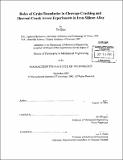| dc.contributor.advisor | Ali S. Argon. | en_US |
| dc.contributor.author | Qiao, Yu, 1972- | en_US |
| dc.contributor.other | Massachusetts Institute of Technology. Dept. of Mechanical Engineering. | en_US |
| dc.date.accessioned | 2005-10-14T19:27:55Z | |
| dc.date.available | 2005-10-14T19:27:55Z | |
| dc.date.copyright | 2002 | en_US |
| dc.date.issued | 2002 | en_US |
| dc.identifier.uri | http://hdl.handle.net/1721.1/29253 | |
| dc.description | Thesis (Ph. D.)--Massachusetts Institute of Technology, Dept. of Mechanical Engineering, 2002. | en_US |
| dc.description | Page 201 blank. | en_US |
| dc.description | Includes bibliographical references (p. 106-200). | en_US |
| dc.description.abstract | High-angle grain boundaries in steel offer an important resistance to the propagation of cleavage cracks that affects the fracture toughness and can modulate the ductile-to-brittle transition temperature of fracture downward. This behavior has been studied in this thesis in detail. In grain-boundary toughness measurement experiments in bicrystals of Fe-3%Si alloy, specific measurements of the fracture resistance of a random selection of high angle grain boundaries and associated fractographic studies have led to quantitative models of the resistance that high-angle grain boundaries offer to cleavage cracks. The study has also revealed a transition from pure cleavage to mixed cleavage (PC/MC) around OC for this alloy. Experiments were also carried out on the modes of advance of cleavage cracks through a field of randomly oriented grains at -30C in the pure cleavage range (lower shelf) in very large grain-sized Fe-2%Si alloy, permitting detailed observations of the chronology of percolation of the cleavage crack front. Utilizing previously developed model-based information on the peak resistance to fracture of high angle grain boundaries, with a given tilt and twist misorientation across them, and detailed measurements of orientations of individual grains in the samples, it was possible to develop percolation maps of cleavage through the field of grains that for the initial phases of fracture through grains predicted the actual path with about 70% accuracy when compared with experimental observations. | en_US |
| dc.description.abstract | (cont.) On the basis of these experiments and modeling a simple expression is projected for the effect of grain boundaries on the overall cleavage fracture resistance of low-carbon steel in the lower shelf region. In addition to the study of behavior of grain boundaries, thermal crack arrest experiments were performed in single crystals of Fe-3%Si alloy. The brittle-to-ductile transition temperatures at various loading rates were measured, and dislocation activities associated with the brittle-to-ductile transition were discussed. | en_US |
| dc.description.statementofresponsibility | by Yu Qiao. | en_US |
| dc.format.extent | 201 p. | en_US |
| dc.format.extent | 7991330 bytes | |
| dc.format.extent | 7991137 bytes | |
| dc.format.mimetype | application/pdf | |
| dc.format.mimetype | application/pdf | |
| dc.language.iso | eng | en_US |
| dc.publisher | Massachusetts Institute of Technology | en_US |
| dc.rights | M.I.T. theses are protected by copyright. They may be viewed from this source for any purpose, but reproduction or distribution in any format is prohibited without written permission. See provided URL for inquiries about permission. | en_US |
| dc.rights.uri | http://dspace.mit.edu/handle/1721.1/7582 | |
| dc.subject | Mechanical Engineering. | en_US |
| dc.title | Roles of grain boundaries in cleavage cracking and thermal crack arrest experiments in iron-silicon alloy | en_US |
| dc.type | Thesis | en_US |
| dc.description.degree | Ph.D. | en_US |
| dc.contributor.department | Massachusetts Institute of Technology. Department of Mechanical Engineering | |
| dc.identifier.oclc | 51832638 | en_US |

